Having experienced the 2008 Retreat last year for a day and a half, I decided to return this year for the full week. Copper wasn’t the only thing which brought me back. The natural beauty of the Keweenaw Peninsula, the history, and the wonderful people involved made this a must-do event.
The dig schedule is fairly straightforward. You go to one location in the morning, one in the afternoon. This may sound restrictive, but three hours is generally enough time to spend at one spot.
Is there copper here? Definitely! Last year I attended using only my eyes for spotting copper. Although I did not find anything large (at the Mohawk Mine, a 9 year old found a fist sized piece of copper sitting on the surface which adults with metal detectors had passed over!), I did find disseminated copper (that is scattered within a rock sample).
This year I was armed with a modest priced metal detector which located nice pieces of sheet copper and even an 1" copper chisel chip. Was having a detector necessary, no, but it did allow me to find pieces buried below the surface or obscured with dirt. Would I recommend using a unit? Most definitely since the rock piles were churned up and everything covered in dirt.
As for fancy, expensive units compared to entry level ones (mine would fit into this category), let me give you a few impressions I gained. First, every metal detector will find you copper. What I noticed about the better ones is that you can refine your search to seek out only copper instead of iron. A couple who found three nice pieces of Mohawkite had a better detector, but I am not sure if it was the detector or simply being in the right spot before anyone else showed up. Others with expensive metal detectors failed to find any Mohawkite. Success is mostly serendipity.
To dispel any misconceptions or myths, the mine dumps were churned up the morning of the dig. This ensured that no one could search the dig area before everyone else. The retreat guides were very honest about letting everyone begin their search at the same time, on time. The equipment was a digger with an arm capable of reaching up, out, or down to disturb the rock piles.
To kick off the week, I attended the mineral identification seminar on late Sunday afternoon. A very concise yet descriptive geologic history is presented and then the most common minerals are discussed. Questions ranging from how to clean copper to scuba diving in Lake Superior were asked. This is really a must event to provide you with an introduction on what minerals you may encounter.
Most of the week I stayed at McClain State Park, just outside Houghton and situated along Lake Superior. The location can’t be beat since you are so close to the mine dumps and the cities.
The following is a list of Mines I visited during the week:
Monday - August 3, 2009
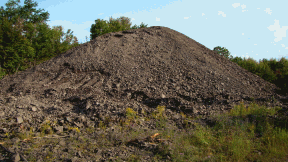
Wolverine Mine: Like many of the mind dumps, there was a tall mound of broken rock which had been churned up at one corner. Actually, the area in which was churned was less than an acre in size. The focus of this dig were chlorite-copper amygdules and agates. Yes, agates! Pea to quarter sized, but none the less agates. There was not much copper found here, but as with all places, there is copper present.
The agates in question were little chlorite-quartz-feldspar filled vugs called amygdules. Many were smaller than peas with a few the size of a nickel the largest about the size of a quarter. Remarkably, they fell out of the basalt quite easily after the rock had been cracked. Of course it took a lot of pounding and many were broken at one end, but they were still prized, especially those which contained copper.
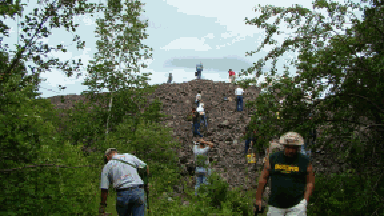
Mohawk Mine:
This is one of the most desired mines to search. The focus of course being Mohawkite, a copper-arsenate-nickel-copper "mineral". The Mohawk was not as giving this year as when I visited last year. One couple found three peach to fist sized pieces of Mohawkite that they found in one spot. No one else found any, last year a number of people found some.I happened upon a two to three foot sized piece of basalt with a thin band of copper running through it. After pounding it for over fifteen minutes with a sledgehammer, I managed to knock off a small piece. Word of advice: Don’t waste your time on very hard rocks. Save your energy for easier finds.
Tuesday - August 4, 2009
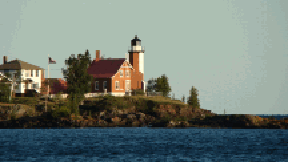
Lighthouse at Eagle Harbor.
Central Exploration Mine: This was one of the most successful digs for me. I found a pair of fist plus sized copper sheets while others found large sized pieces of sheet copper too. Overall, I would rate this one of the most productive spots on the Retreat.
The following is a great piece of copper, requiring little cleaning other than brushing off the dirt. However, I did give it an acid bath to look for silver. Although I did not see any with this one, a 3” X 4” sheet copper found at Central Mine did have some silver on it.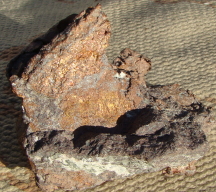
Central Mine: My biggest find occurred here. A large dish plate sized sheet of copper encased in an inch thick layer of rock nearly sent me to the moon. People were finding copper chisel chips (pieces of chipped copper when miners were cutting large chunks of copper in the mines). Aside from the large chunk, I found numerous smaller pieces of sheet copper.
The following piece may not look like much, but it is sandwiched with copper. At 11” tall and 12” wide, I really flipped out when the metal detector beeped. Not until I was digging for several minutes did I have an idea how large this really was. While large, the only way to see the copper would be to put it into a hydrofluoric acid bath, something I’d never do myself. Maybe someday I’ll send it out for a bath. Still makes a great display piece.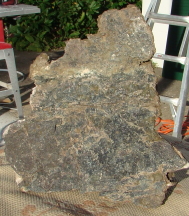
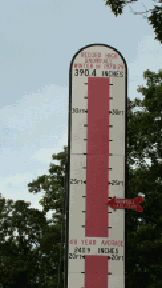
Wednesday - August 5, 2009
My day off. There were only two all day digs today, one for Datolites and the other at the Caledonia Mine. I moved from Mc Lane State Park to Twin Lakes State Park to be closer to the next dig. Ironically, I decided to go back up the Keweenaw to scout out parts of the peninsula I had not traversed last year. That and I missed the rock swap Tuesday night. Don’t miss it! You can get some nice pieces at reasonable prices plus rub elbows with the Copper Country Club members.
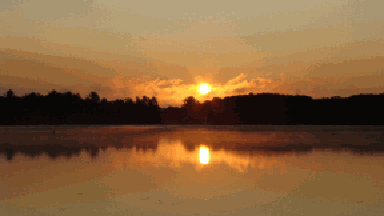
Dawn at Twin Lakes State Park
Thursday - August 6, 2009
Michigan Mine: This was one of the oddest digs. Not because most people parked at the top of a ridge and then hiked down or that the talus pile was scattered on the lower part of the ridge slope. Rather, my metal detector simply did not work. Or at least that was what I thought. At all the other mines, I always ran across something which would set it off. But not here.
Fearing run down batteries (they were fresh, but not knowing how long they would last since this was the first time I was using the metal detector) I went ahead and replaced them. This made no difference. Yet other people’s detectors were beeping or squawking (they make the most peculiar noises). So I went visual.
A lot of burnt red microcline was present, but little copper. Someone did find a nice piece of copper, so it is here. With so little copper, I focused on calcite filled microcline vugs. I have found many wonderful micro crystals within these calcite filled vugs, so the visit was not a wash.
As a side note, the Michigan Mine has produced a number of hatchet heads used by Indians going back for thousands of years. Several people in my group found such heads.
Note: After returning home, some of the acid bath samples did contain nice pieces of copper. For some reason the metal detector did not indicate there being any copper in these samples.
Baltic Mine: The Baltic produced a nice twin golf ball sized copper crystals. Unfortunately, I was not the discoverer! Still, there was a lot of copper to be found. The specialty here were Chalcocite and Chalcopyrite. Vein calcite was quite abundant, many of which were light tan to dark brown in color. Several of us speculated that this was Ankerite, but the guide mentioned that this mine contained a lot of iron and so the color was simply iron staining. Indeed, beneath the colored zone was ‘white’ calcite. However, it could still be Ankerite since a fresh face would not have oxidized. When I have time, I plan on testing for Ankerite.
The veins turned out to be a critical clue in finding Chalcocite. Many of the veins contained thin to thick layers of this copper sulfide mineral. Ironically despite containing copper, the metal detectors did not go off.
Next to the great copper crystal find, the best piece was a foot plus sized breccia which contained a great zone of Chalcocite. The possessor of this piece said someone else found it, wasn’t impressed with it and left it, so they guy claimed it! It was certainly the best looking specimen collected this day.
Looking for a particular mineral is like looking for Morel mushrooms. Once your brain is programmed to recognize the shape, you can spot it readily. Chalcocite turned out to be everywhere. I collected far more than I needed, but I am always looking for material to hand out to 4-H kids.
Friday - August 7, 2009
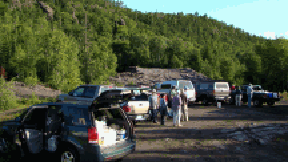
Cliff Mine: Another great collecting spot. There is a lot of copper present. Here I found an inch sized copper chisel piece. In addition, I stumbled upon a 2 x 3 x 1 foot boulder which contained a great copper vein. Not having my sledgehammer with me, I used my crack hammer to knock off a 1’ x 3" x 1" of the vein. Satisfied with this piece, I handed the remains to an elderly couple and their son. He managed to break up the remainder in to more manageable sized pieces. Turns out that the father built a hydrofluoric acid tank for a rock dealer neighbor. I guess had I held onto the entire piece, I would have had one of those large copper pieces found in rock shops or even EBay. However, by this time I was bushed.
The following was a wonderful surprise and why I do acid baths. On the right side of the photo is a great sample of silver, one of several in this piece. The copper looks bright because I had just rinsed it after an acid bath. The copper and silver tarnish as it dried.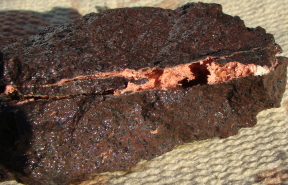
There were also bits and pieces of Prehnite scattered about in the non-disturbed area a few of which contained nice crystals. Given the amount of copper found and the Prehnite present, this was one of the better mines I visited.
There are two water hazards to cross if you wanted to park next to the dumps. The first was a ditch and then there was the creek, in most places wide enough that you could jump over it, but the crossing point was almost a lake.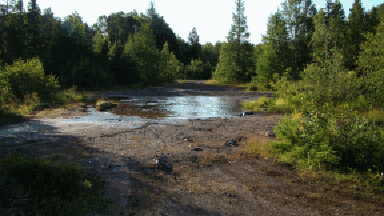
Phoenix Mine: The fabled ‘greenstone’ is found here. If the Mohawk Mine is to Mohawkite, then the Phoenix is to greenstone. Greenstone is a form of Pumpellyite var Chlorastrolite and like amygdule agates, are found in small vugs in the basalt. While abundant, the key to finding greenstone is to look for green amygdaloidal basalt. The difficulty is twofold, the abundant dirt covering the rock, and two, at first glance greenstone looks very similar to chlorite.
The retreat people provided water to wash off the rocks to assist in our search, a great asset in this task. Experienced rock hounds brought their own water spray bottles. Water really does help find the fabled greenstone.
While successful in finding a few greenstones, they did not impress our guide because they were so small. However, by this point I was losing interest in greenstones. Many people did find nice ones, but they were at best pea sized or slightly larger.
Before the dig began, someone was telling me about the Phoenix dump. Apparently, the dump is owned by two people. The dig was located just on one owner’s land. Supposedly, the other owner has a tall tower located up on the Green flow ridge above the dump. Whenever he sees anyone trespassing, he speeds down to chase people away. Since that side of the dump does not look pawed over, there may be some truth to this story.
As a last hurrah, I wandered over to an area where greenstones were not abundant. Almost immediately, I stumbled upon a sizable rock which someone else had examined and then left behind. It was another copper rock which I couldn’t leave behind. My hope is to slice and polish it if it is good quality.
Epilogue: My excitement peaked the moment I arrived in Houghton on Sunday afternoon. The next two days were spectacular, especially after the big finds on Tuesday. Then came the Baltic and then the Cliff Mines. These were what coming to Copper Country was all about. When I arrived at the Phoenix, just a short drive from the Cliff Mine, I was already missing everything.
As I glanced back in my rearview mirror, I thought of all the good times from this past week. Then thoughts of next year began flicking through my tired mind….
This year was spectacular because of the great weather. Hitting the road shortly after daybreak, looking, searching, and exploring before the first morning dig, I put on more miles than necessary. But I wanted to become more familiar with the Keweenaw Peninsula. Despite all this exploring, there is still so much more I haven’t seen. And so now, I am daydreaming about next year. Who knows, I might even bring my family along then. Then of course, there is only so much room inside my Saturn Vue.
